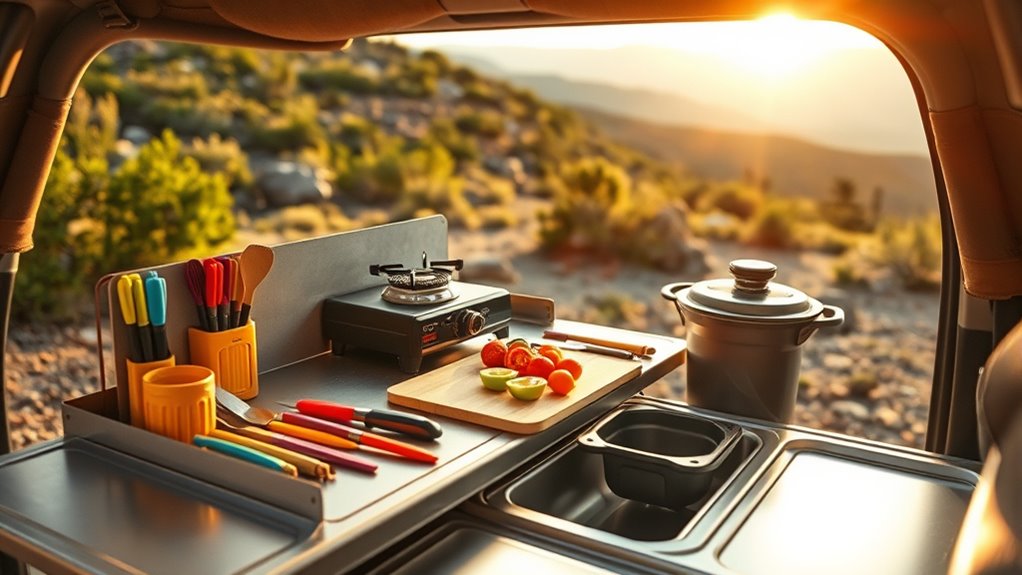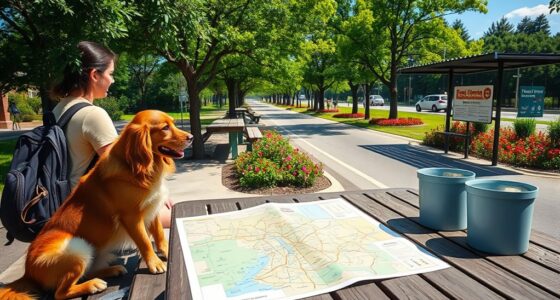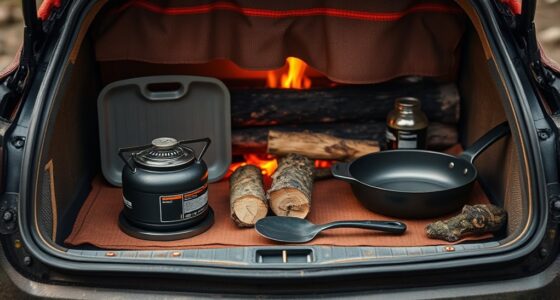To build your DIY car-camping kitchen, start by planning a compact layout that maximizes space for prep, cooking, and storage. Choose durable, waterproof materials like marine-grade plywood or aluminum, and gather essential tools. Construct a sturdy base with organized compartments, then securely install appliances and hooks for utensils. Finish with safety features such as fire extinguishers and non-slip surfaces. If you keep exploring, you’ll discover detailed tips to make your setup more efficient and safe.
Key Takeaways
- Plan an efficient, space-maximizing layout with designated cooking, prep, and storage zones for ease of use.
- Select waterproof, corrosion-resistant materials like marine plywood or aluminum for durability.
- Build a lightweight, level base structure with organized storage solutions such as drawers or shelves.
- Securely install appliances and utility hooks, ensuring proper ventilation and weight distribution.
- Add safety features like fire extinguishers, reinforce loose fixtures, and double-check all connections before use.
Planning Your Kitchen Layout and Essential Features
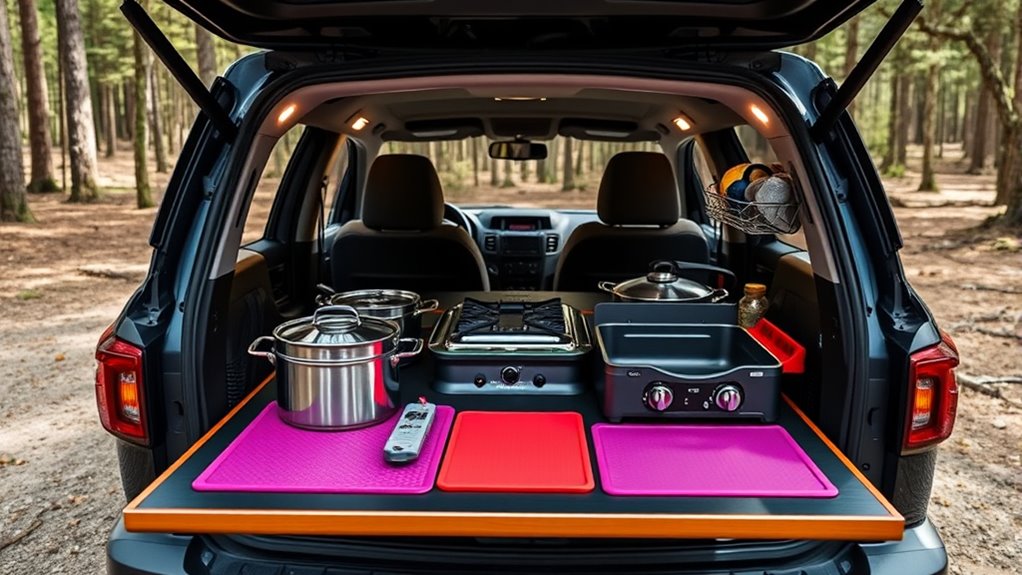
Before building your DIY car-camping kitchen, it’s important to plan an efficient layout that maximizes space and functionality. Think about how you’ll use the area: do you need a stove, prep space, or storage? Position the cooking surface near the main work zone for easy access, and include enough counter space for prep work. Incorporate storage compartments for utensils, pots, and food, keeping everything within reach. Consider a fold-out or slide-out design to save space when not in use. Make sure to leave room for ventilation and safety measures. Prioritize features that streamline your cooking process and ensure convenience. Additionally, choosing lighting options can greatly enhance usability and safety during meal preparation. Proper lighting not only improves visibility but also contributes to overall safety in a compact space. Selecting portable power sources like power banks or portable solar panels can keep your equipment running smoothly without adding bulk. Being aware of regional weather conditions can help you plan for insulation or protection measures to keep your kitchen functional in various climates. With a well-thought-out layout, you’ll create a compact yet fully functional kitchen tailored to your camping adventures.
Selecting Materials and Tools for Construction
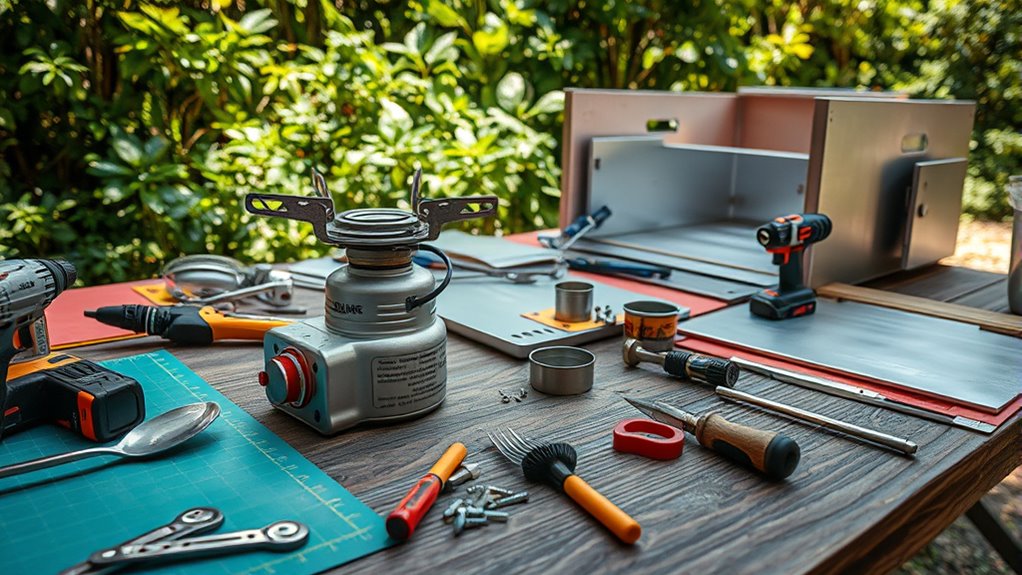
Choosing the right materials and tools is essential to building a durable, lightweight, and functional DIY car-camping kitchen. Opt for waterproof, corrosion-resistant materials like marine-grade plywood or aluminum for the structure. These materials withstand outdoor conditions and keep weight manageable. For surfaces, consider heat-resistant, easy-to-clean options such as laminated plywood or stainless steel. When selecting tools, gather a reliable drill, saw, screwdriver, measuring tape, and clamps. A jigsaw or circular saw makes cutting easier, while a power drill speeds assembly. Don’t forget safety gear like gloves and goggles. Quality tools ensure precise cuts and sturdy joints, reducing frustration. Focus on lightweight, weatherproof materials to maximize portability and longevity, ensuring your kitchen stands up to outdoor adventures. Additionally, understanding cotton candy sugar colors and their impact can inspire creative design choices for your outdoor kitchen accessories, especially when considering material durability and how it influences your project’s success. Incorporating knowledge of water parks can provide ideas for creating splash-resistant features or fun outdoor elements, enhancing your camping experience.
Building the Base Structure and Storage Solutions
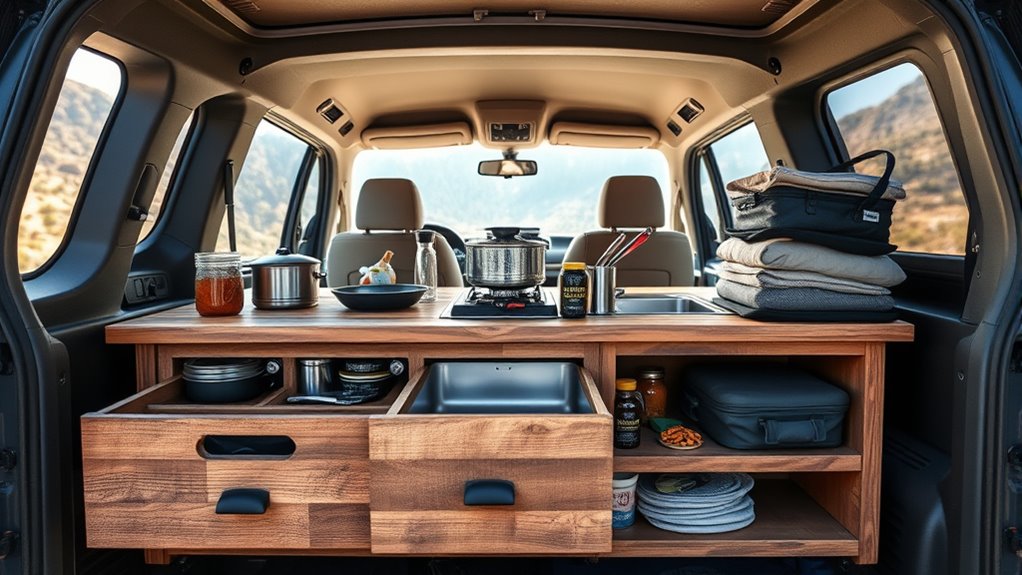
How do you create a sturdy, functional base for your DIY car-camping kitchen? Start by measuring your available space accurately. Choose lightweight, durable materials like plywood or aluminum for the frame, guaranteeing it can support your equipment and supplies. Build a flat, level platform that fits snugly in your vehicle’s cargo area or trunk. Incorporate storage solutions such as drawers, shelves, or bins to keep utensils, cookware, and food organized. Secure everything with brackets or straps to prevent shifting during transit. Consider adding fold-out or collapsible sections for versatility. Keep the design simple yet robust, prioritizing stability and accessibility. A well-built base ensures your kitchen remains steady, organized, and ready for your outdoor adventures. Proper measurements are essential to ensure a perfect fit and optimal functionality. Additionally, understanding AI in Education can inspire innovative features like digital organization tools or smart sensors to enhance your setup. To further improve stability, you might explore weight distribution techniques that help balance your gear effectively.
Installing Cooking Appliances and Utility Hooks

To guarantee your DIY car-camping kitchen functions efficiently, you need to carefully install your cooking appliances and utility hooks. Secure your stove in a stable spot, ensuring proper ventilation and easy access. Use sturdy brackets and screws to prevent shifting while driving. Utility hooks are essential for hanging utensils, towels, or spice bags. Position hooks near your workspace for quick access. Consider layout and weight distribution to avoid imbalance. Additionally, self watering plant pots can be useful for keeping small herbs fresh and accessible during your trip. Incorporating sound vibrations into your setup can also promote a calming environment and improve air quality in your confined space. Paying attention to spatial organization will maximize efficiency and safety in your compact outdoor kitchen.
Finishing Touches and Safety Considerations
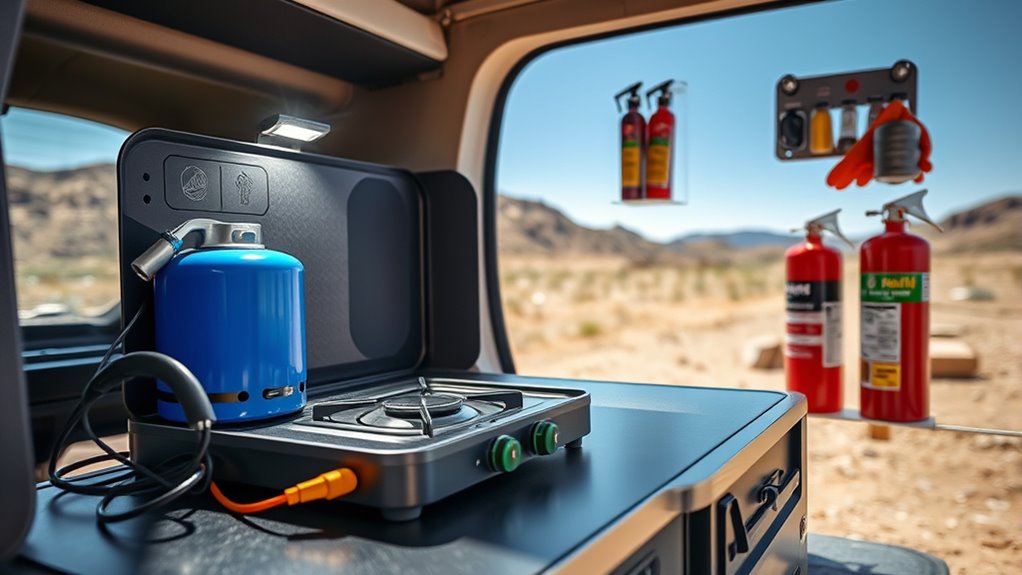
After securing your appliances and hooks, it’s time to focus on finishing touches and safety measures that keep your setup reliable and secure. First, double-check all connections, ensuring gas lines and electrical components are tight and leak-free. Second, install fire extinguishers or safety blankets nearby, so you’re prepared for emergencies. Ultimately, reinforce any loose panels or fixtures to prevent shifting during travel. Additionally, consider adding non-slip mats to stabilize your setup and prevent spills. Use heat-resistant materials around cooking areas to avoid damage or accidents. Regularly inspect your setup for signs of wear or damage, especially before each trip. These steps help ensure your DIY kitchen remains safe, functional, and ready for any adventure.
Frequently Asked Questions
How Can I Make My DIY Camping Kitchen More Eco-Friendly?
You can make your camping kitchen more eco-friendly by choosing reusable and biodegradable items, like compostable plates and utensils. Opt for solar-powered lights or a portable stove that uses eco-friendly fuel. Reduce waste by planning meals carefully to avoid leftovers, and pack out all trash. Use minimal water and avoid single-use plastics. By making these small changes, you help protect the environment while enjoying your outdoor adventures.
What Are the Best Ways to Secure the Kitchen During Travel?
To keep your camping kitchen secure during travel, you should first use sturdy straps or bungee cords to fasten all items tightly. Make sure heavier appliances are secured in place and that loose parts are stored properly. Also, consider using non-slip mats or padding to prevent shifting. Regularly check your setup before hitting the road to guarantee everything stays in place, so you can enjoy your trip worry-free.
How Do I Maintain Hygiene and Cleanliness in a Portable Kitchen?
You guarantee hygiene and cleanliness in your portable kitchen by washing all utensils and surfaces regularly with soap and water. Use disinfectants on counters and cutting boards, and keep cleaning supplies handy. Store food properly in sealed containers, and discard trash promptly. Dry dishes thoroughly to prevent mold, and wash your hands often. Staying organized and attentive to cleanliness keeps your cooking area safe and enjoyable during your adventures.
Can I Customize the Kitchen for Different Types of Camping Trips?
Think of your kitchen as a blank canvas, ready to adapt to your adventure. You can definitely customize it for different trips—add extra shelves for longer stays or compact tools for quick getaways. Use versatile storage solutions and modular components that can be rearranged. This way, your kitchen becomes a reflection of your journey, seamlessly transforming to meet your needs, no matter where the road takes you.
What Are Cost-Effective Alternatives to High-End Cooking Appliances?
When looking for cost-effective alternatives to high-end cooking appliances, you can consider portable stoves like butane or propane models, which are affordable and versatile. Using basic cookware like cast iron or lightweight aluminum pots saves money and lasts longer. You might also opt for manual tools such as hand-crank grinders or simple utensils, allowing you to cook efficiently without splurging on fancy electric gadgets.
Conclusion
Building your DIY car-camping kitchen is a rewarding project that boosts your outdoor adventures. Did you know that over 60% of campers say a well-equipped kitchen enhances their trip? By planning carefully, choosing durable materials, and adding personal touches, you’ll create a functional space tailored to your needs. With a little effort, you’ll enjoy delicious meals on the road and make unforgettable memories—because the right setup can turn any camping trip into a home away from home.
